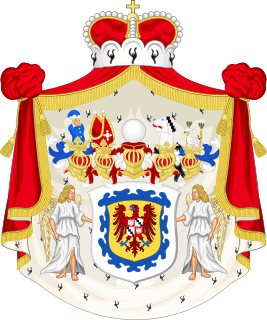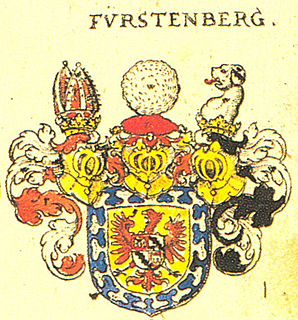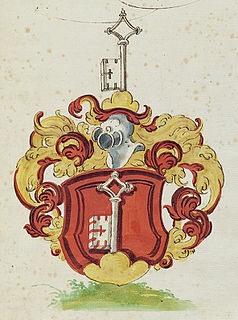Related Research Articles

The House of Fürstenberg is the name of an old and influential Swabian noble house in Germany, based primarily in what is today southern Baden-Württemberg near the source of the Danube river.

Sigmaringen Castle was the princely castle and seat of government for the Princes of Hohenzollern-Sigmaringen. Situated in the Swabian Alb region of Baden-Württemberg, Germany, this castle dominates the skyline of the town of Sigmaringen. The castle was rebuilt following a fire in 1893, and only the towers of the earlier medieval fortress remain. Schloss Sigmaringen was a family estate of the Swabian Hohenzollern family, a cadet branch of the Hohenzollern family, from which the German Emperors and kings of Prussia came. During the closing months of World War II, Schloss Sigmaringen was briefly the seat of the Vichy French Government after France was liberated by the Allies. The castle and museums may be visited throughout the year, but only on guided tours. It is still owned by the Hohenzollern-Sigmaringen family, although they no longer reside there.

The House of Helfenstein was a German noble family during the High and Late Middle Ages. The family was named after the family castle, Castle Helfenstein, located above Geislingen an der Steige in the Swabian Alb region of Baden-Württemberg, Germany. The family held the rank of Graf or Count and was very significant in the 13th and 14th Centuries, but fell into financial difficulties and the family lost his estate in 1627. Later the main branch of the family emigrated to America and even today they are successor members of this German dynasty. Currently the german-argentinean Ernst Heinrich von Helfenstein have the honorary title by inheritance of Baron and Count by subsequent to his Father.

Josef Friedrich Wilhelm, was prince of Hohenzollern-Hechingen from 1750 until his death.
Countess Anna Magdalena von Hanau-Lichtenberg, was a daughter of Count Johann Reinhard I of Hanau-Lichtenberg (1569–1625) and Countess Maria Elisabeth of Hohenlohe-Neuenstein-Weikersheim (1576–1605).

Frederick I, Count of Zollern, was often cited as a powerful Swabian Count and supporter of the imperial party of Henry V, Holy Roman Emperor.

Egon VIII of Fürstenberg-Heiligenberg was Imperial Count of Fürstenberg-Heiligenberg (1618–1635) and Bavarian Field-marshal, and an important military leader in the Thirty Years' War.

Herman Egon, Prince of Fürstenberg-Heiligenberg was Hofmeister, Chamberlain, Privy Councillor and Hofmarschall to Elector Ferdinand Maria of Bavaria. With his brothers Francis Egon and Wilhelm Egon, he played an important role in the imperial election of 1658 in Frankfurt. In 1664, Herman Egon and his brothers were elevated to Imperial Princes.
Johann Georg of Hohenzollern-Hechingen was the first Prince of Hohenzollern-Hechingen.

Count Eitel Friedrich IV of Hohenzollern was the founder and first Count of the line Hohenzollern-Hechingen as Eitel Friedrich I.
Friedrich V of Zollern nicknamed, the Illustrious was a Count of Zollern.

Count Christoph of Hohenzollern-Haigerloch was the first Count of Hohenzollern-Haigerloch.

Prince Johann of Hohenzollern-Sigmaringen, was the ruling Count of Hohenzollern-Sigmaringen from 1606 to 1623. He was elevated to the rank of prince in 1623 and so was Prince of Hohenzollern-Sigmaringen from 1623 until his death.

Friedrich Wilhelm of Hohenzollern-Hechingen was the fourth Prince of Hohenzollern-Hechingen and was also an imperial Field Marshal.
Johann Christoph, Count of Hohenzollern-Haigerloch was the second Count of Hohenzollern-Haigerloch.

Jobst Nikolaus I, Count of Hohenzollern was a German nobleman from the Swabian branch of the House of Hohenzollern. He was the ruling Count of Hohenzollern from shortly after his birth until his death.
Friedrich IX, Count of Hohenzollern, nicknamed "Fredrick the Old" or "the Black Count", was a German nobleman. He was the ruling count of Hohenzollern from 1339 until his death.
Philipp Christoph Friedrich, Prince of Hohenzollern-Hechingen was a German nobleman. He was the third prince of Hohenzollern-Hechingen.

Friedrich XII, Count of Hohenzollern, nickname Friedrich the Oettinger was a German nobleman. He was a member of the Swabian branch of the House of Hohenzollern. His father was Friedrich XI, Count of Hohenzollern; his younger brother and rival was Eitel Friedrich I, Count of Hohenzollern.

Schlüsselberg was a Franconian aristocratic family which was a member of the high nobility. Until it died out in 1347, the family was able to establish itself firmly in the region of Franconian Switzerland and turned out to be unwelcome competition for the bishops of Bamberg. The Schlüsselbergs founded inter alia the town of a number of Schlüsselfeld in 1336 as well as Schlüsselau Abbey.
References
- Count Rudolph Stillfried-Alcántara and Traugott Maercker: Hohenzollerische Forschungen, C. Reimarus, 1847, p. 203 ff.
- E. G. Johler: Geschichte, Land- und Ortskunde der souverainen teutschen Fürstenthümer Hohenzollern Hechingen und Sigmaringen, Stettin'sche Buchhandlung, Ulm, 1824, Online
- Gustav Schilling: Geschichte des Hauses Hohenzollern in genealogisch fortlaufenden Biographien aller seiner Regenten von den ältesten bis auf die neuesten Zeiten, nach Urkunden und andern authentischen Quellen, Fleischer, Leipzig, 1843, Online